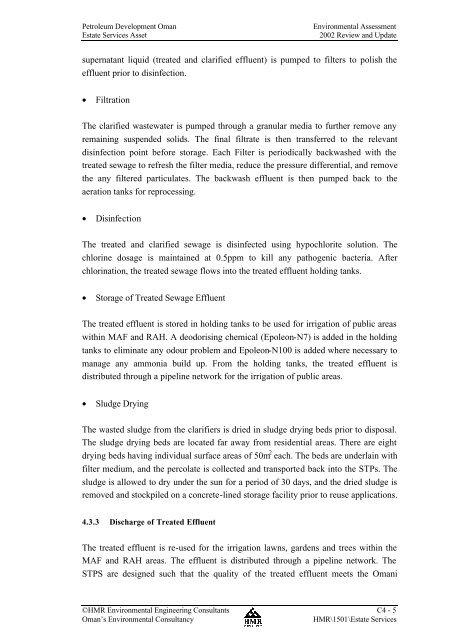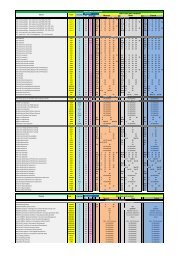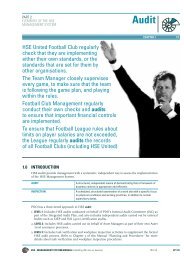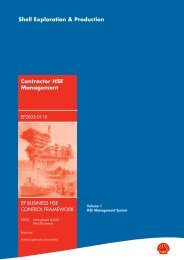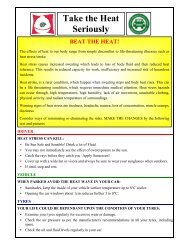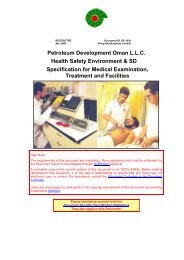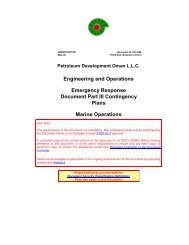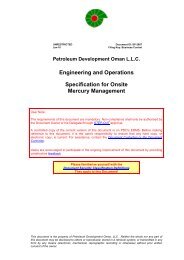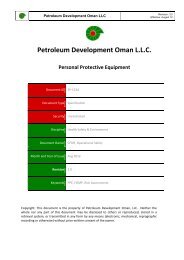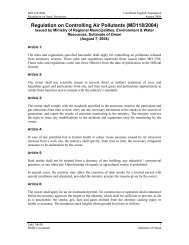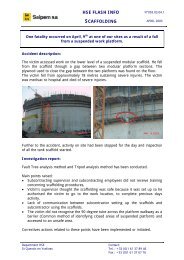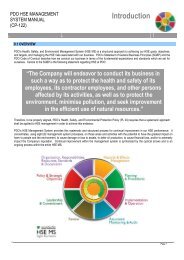Estate Service Asset - PDO
Estate Service Asset - PDO
Estate Service Asset - PDO
Create successful ePaper yourself
Turn your PDF publications into a flip-book with our unique Google optimized e-Paper software.
Petroleum Development Oman<br />
<strong>Estate</strong> <strong>Service</strong>s <strong>Asset</strong><br />
Environmental Assessment<br />
2002 Review and Update<br />
supernatant liquid (treated and clarified effluent) is pumped to filters to polish the<br />
effluent prior to disinfection.<br />
• Filtration<br />
The clarified wastewater is pumped through a granular media to further remove any<br />
remaining suspended solids. The final filtrate is then transferred to the relevant<br />
disinfection point before storage. Each Filter is periodically backwashed with the<br />
treated sewage to refresh the filter media, reduce the pressure differential, and remove<br />
the any filtered particulates. The backwash effluent is then pumped back to the<br />
aeration tanks for reprocessing.<br />
• Disinfection<br />
The treated and clarified sewage is disinfected using hypochlorite solution. The<br />
chlorine dosage is maintained at 0.5ppm to kill any pathogenic bacteria. After<br />
chlorination, the treated sewage flows into the treated effluent holding tanks.<br />
• Storage of Treated Sewage Effluent<br />
The treated effluent is stored in holding tanks to be used for irrigation of public areas<br />
within MAF and RAH. A deodorising chemical (Epoleon-N7) is added in the holding<br />
tanks to eliminate any odour problem and Epoleon-N100 is added where necessary to<br />
manage any ammonia build up. From the holding tanks, the treated effluent is<br />
distributed through a pipeline network for the irrigation of public areas.<br />
• Sludge Drying<br />
The wasted sludge from the clarifiers is dried in sludge drying beds prior to disposal.<br />
The sludge drying beds are located far away from residential areas. There are eight<br />
drying beds having individual surface areas of 50m 2 each. The beds are underlain with<br />
filter medium, and the percolate is collected and transported back into the STPs. The<br />
sludge is allowed to dry under the sun for a period of 30 days, and the dried sludge is<br />
removed and stockpiled on a concrete-lined storage facility prior to reuse applications.<br />
4.3.3 Discharge of Treated Effluent<br />
The treated effluent is re-used for the irrigation lawns, gardens and trees within the<br />
MAF and RAH areas. The effluent is distributed through a pipeline network. The<br />
STPS are designed such that the quality of the treated effluent meets the Omani<br />
©HMR Environmental Engineering Consultants C4 - 5<br />
Oman’s Environmental Consultancy<br />
HMR\1501\<strong>Estate</strong> <strong>Service</strong>s


